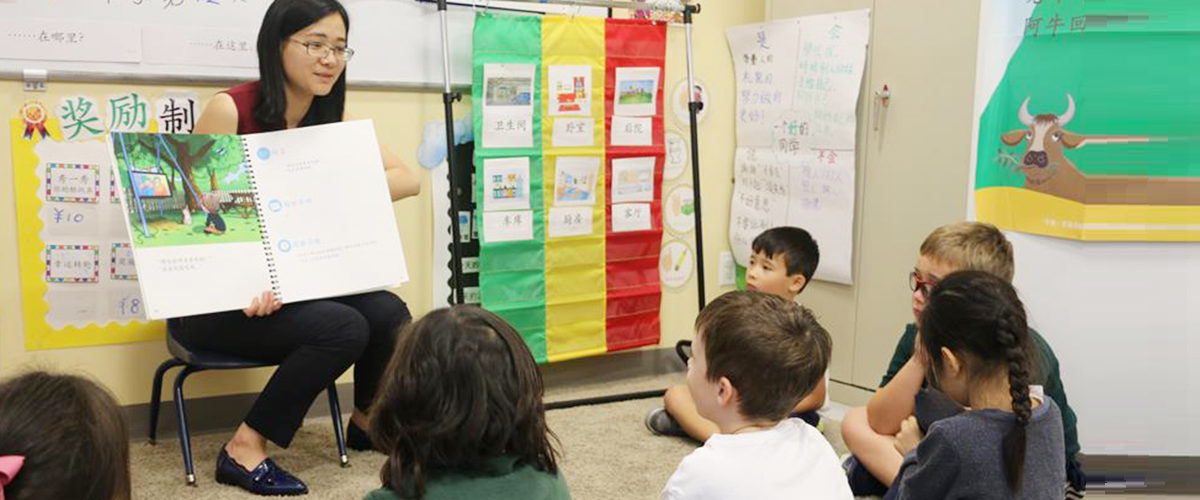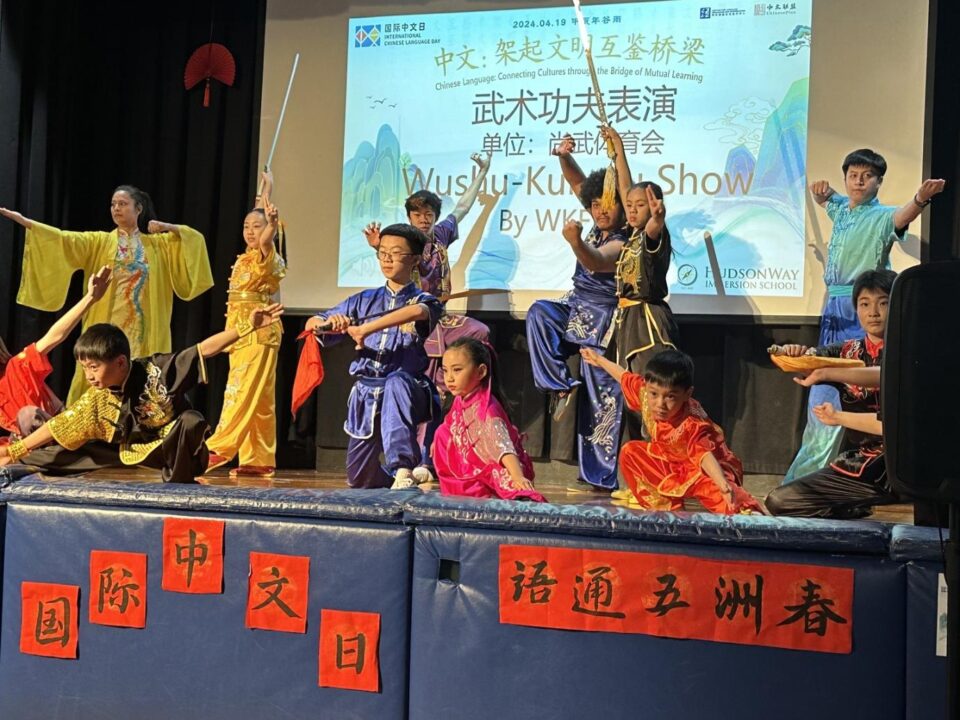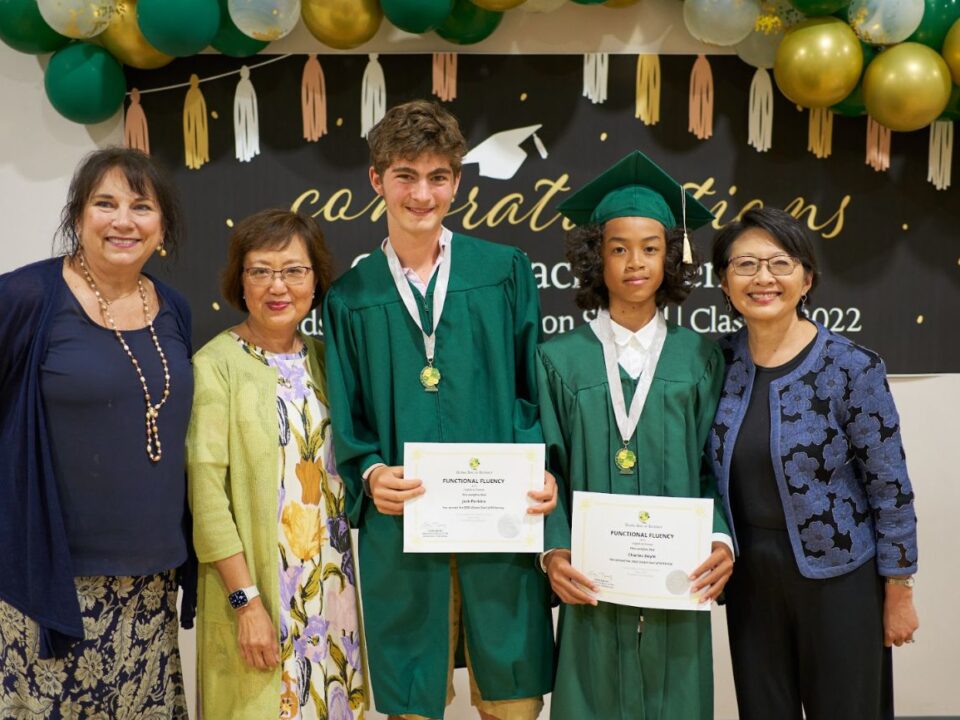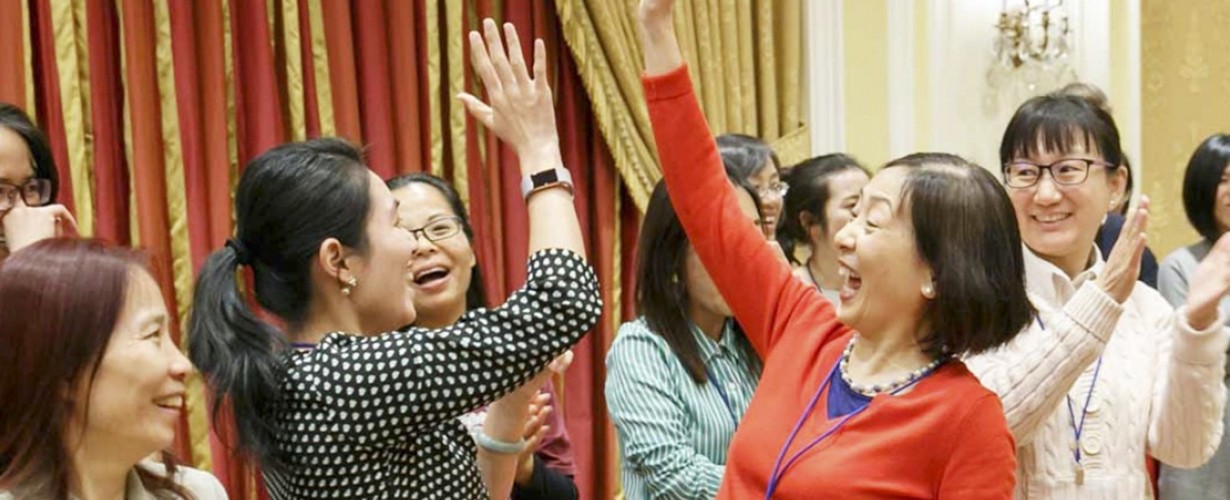
Trump’s policies may make it harder for US to find Chinese teachers
September 16, 2018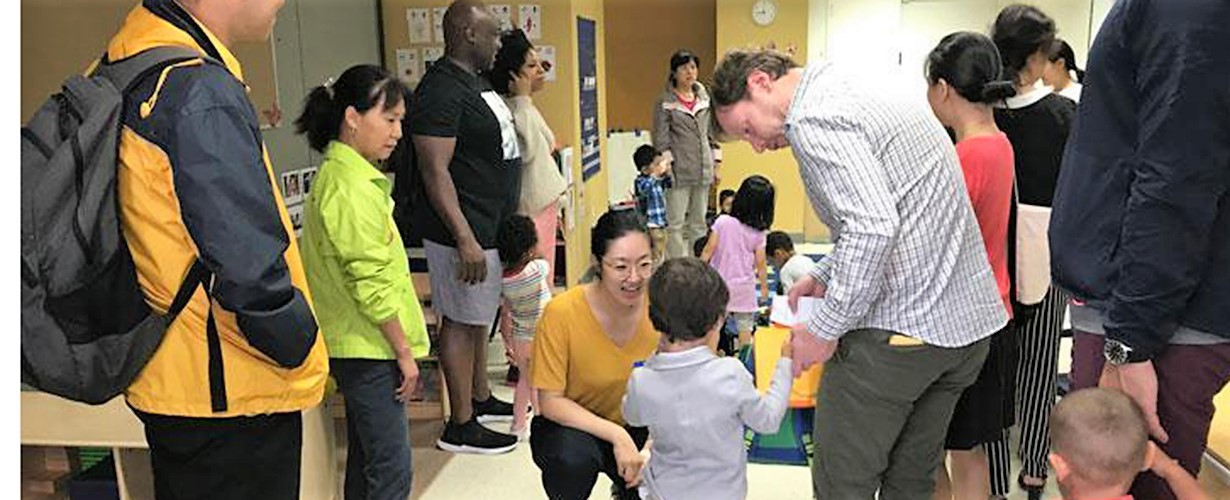
“The Separation Process: How Is It Done in an Immersion Environment?
January 5, 2019Yang Ying, a Chinese teacher at HudsonWay Immersion School in New York, is teaching kindergarten students how to make plasticine in classroom in Chinese. ZHANG RUINAN. CHINA DAILY
By ZHANG RUINAN in New York | China Daily USA
Chinese-language learning is soaring in US public and private schools, but school officials say the stricter immigration policies of the Trump administration are making it difficult to retain and find enough qualified teachers.
Sharon Huang, the founder of HudsonWay Immersion School, said that she holds her breath and prays for several of the Chinese-language teachers at her two schools to get work visas to continue teaching.
"We've had teachers who were denied work visas and they cannot continue to stay in the US; that's very difficult for us as a school. We've invested time training the teachers, and the teachers are happy about their life here," said Huang. "More importantly, the families and children are happy with the teachers, so you don't want to have to change teachers during a school year."
The schools Huang runs in New York City and Stirling, New Jersey, have about 200 students and around 27 Chinese-language teachers, most of whom are native Chinese and stay in the US for up to six years on the H-1B visa for skilled foreign workers.
This year, Huang filed around a half-dozen applications for her teachers for the work visa, and a couple of the teachers did not get an H-1B visa through the lottery system or were asked for further evidence to justify why they deserve the visa.
"We've seen more questioning in this administration and we've seen some changes (on H-1B visas)," Huang said. "The difficult thing for us is in other industries, whether you hire an engineer for overseas may or may not be necessary, but for us, with the nature of this, we have to have native speakers. It just makes the whole mission more challenging, even though the US government has stated that it wants a lot of students in America to study Chinese."
The Trump administration's tightening on immigration has meant stronger scrutiny, longer processing time and fewer approvals for work visas.
"We've seen many more strict rules on H-1B visas after President Trump took office," said Fang Peng, a New York-based Chinese immigration lawyer with more than 20 years' experience representing H-1B applicants. "And a growing number of applicants received initial requests for evidence (RFE), in which additional documents are required to support an application's eligibility."
This year, during the filing period in April, the United States Citizenship and Immigration Services (USCIS) received 190,098 H-1B applications, a decrease of about 4.5 percent compared with last year. Last year, RFEs increased 45 percent, data from USCIS show.
"The higher level of scrutiny for H-1B visas is one of the indicators of Trump's restriction on immigrant visas," Fang said, adding that the changes were part of Trump's directive to federal agencies to implement a "Buy American, Hire American" strategy.
Hiring a native Chinese speaker is crucial for the American schools offering Chinese-language programs and especially for schools with an immersion curriculum, where elementary students take at least half their classes in Mandarin.
"We have about 10 Chinese teachers in our school, and most of them are native speakers from China," said Chang, educational director of an immersion Chinese program for early childhood in New York City. "We are looking for native speakers because we have to; they must have academic fluency in writing and reading — and they also need to have educational backgrounds."
Chang, who asked that her full name and the name of her program not be revealed, said most foreign teachers in her program are international students, and they must apply for H-1B visas if they want to stay in the US.
"It's getting more and more difficult in the recent years," Chang said. "We provide sponsorship for the work visa, but the scrutiny is getting stronger and we must prepare additional documents for our teachers to get approval — but some still got denied."
"I applied for the work visa this year, and I received the RFE two months ago," said Amy Chen, who got her master's degree in early childhood education from Teachers College of Columbia University last year. "I have to stop working while I'm waiting for the results, and it's in the middle of the fall semester — the kids in my class were very frustrated."
Chen works for an immersion program in New Jersey and she plans to go back to China if she cannot get approval. "I really want to stay here to teach Chinese but I have no choice," she said.
"There has definitely been an increased interest in learning Chinese. When schools are adding languages, they are intent on diversifying their language offerings, and many are interested in adding Chinese," Marty Abbott, the executive director of American Council on the Teaching of Foreign Languages (ACTFL) told China Daily.
"The 2007-08 enrollments reflected only about 50,000 students learning Mandarin, and the latest figures for 2017 indicate 227,086, or around 2.13 percent of students taking languages," Abbott said, adding that the number reflects both public and private schools but does not take into account the high number of students learning Chinese in weekend or after school programs.
Abbott said that at the same time, the demand for teachers has grown, and if a school adds Chinese, it needs to find a qualified teacher.
Foreign language teachers are in short supply in general throughout the United States. Some 44 out of 50 states report having problems filling positions for these teachers, according to 2017 data from the American Academy of Arts and Sciences.
"The Chinese government has been helpful by sending 'guest teachers' through a program with The College Board, but these teachers can only stay a maximum of three years," Abbott said.
"There has been increased interest in finding native or near-native speakers here in the US who can become certified to teach Chinese at the K-12 level."
"I got my bachelor's degree on early childhood education at the Miami University in Ohio," said Yang Ying, a Chinese teacher who won the H-1B visa lottery last year at the HudsonWay Immersion School. "There were only three Chinese students in the early childhood education program in our class, and the other two girls all went back to China because they can't stay here."
Yang said because the H-1B sponsorship costs a school several thousand dollars per application, coupled with the random selection process and stricter scrutiny, it's become very difficult for Chinese students who majored in education in the US and who want to stay in the US to develop their teaching experience.
"I think it's important to remember that overall there is a teacher shortage; there's never been a surplus of teachers," said Stacy Lyon, director of Utah's Chinese dual-language immersion program.
Lyon said that in Utah there are more than 50 public schools offering Chinese-language immersion programs, and each year she hires about 40 teachers from China, most of whom are guest teachers on J-1 visas for visiting scholars.
She said that this year there also has been increased scrutiny of the J-1 visas, and two or three teachers were denied visas, which she said is quite unusual.
Contact the writer at ruinanzhang@chinadailyusa.com
By ZHANG RUINAN in New York | China Daily USA
Chinese-language learning is soaring in US public and private schools, but school officials say the stricter immigration policies of the Trump administration are making it difficult to retain and find enough qualified teachers.
Sharon Huang, the founder of HudsonWay Immersion School, said that she holds her breath and prays for several of the Chinese-language teachers at her two schools to get work visas to continue teaching.
"We've had teachers who were denied work visas and they cannot continue to stay in the US; that's very difficult for us as a school. We've invested time training the teachers, and the teachers are happy about their life here," said Huang. "More importantly, the families and children are happy with the teachers, so you don't want to have to change teachers during a school year."
The schools Huang runs in New York City and Stirling, New Jersey, have about 200 students and around 27 Chinese-language teachers, most of whom are native Chinese and stay in the US for up to six years on the H-1B visa for skilled foreign workers.
This year, Huang filed around a half-dozen applications for her teachers for the work visa, and a couple of the teachers did not get an H-1B visa through the lottery system or were asked for further evidence to justify why they deserve the visa.
"We've seen more questioning in this administration and we've seen some changes (on H-1B visas)," Huang said. "The difficult thing for us is in other industries, whether you hire an engineer for overseas may or may not be necessary, but for us, with the nature of this, we have to have native speakers. It just makes the whole mission more challenging, even though the US government has stated that it wants a lot of students in America to study Chinese."
The Trump administration's tightening on immigration has meant stronger scrutiny, longer processing time and fewer approvals for work visas.
"We've seen many more strict rules on H-1B visas after President Trump took office," said Fang Peng, a New York-based Chinese immigration lawyer with more than 20 years' experience representing H-1B applicants. "And a growing number of applicants received initial requests for evidence (RFE), in which additional documents are required to support an application's eligibility."
This year, during the filing period in April, the United States Citizenship and Immigration Services (USCIS) received 190,098 H-1B applications, a decrease of about 4.5 percent compared with last year. Last year, RFEs increased 45 percent, data from USCIS show.
"The higher level of scrutiny for H-1B visas is one of the indicators of Trump's restriction on immigrant visas," Fang said, adding that the changes were part of Trump's directive to federal agencies to implement a "Buy American, Hire American" strategy.
Hiring a native Chinese speaker is crucial for the American schools offering Chinese-language programs and especially for schools with an immersion curriculum, where elementary students take at least half their classes in Mandarin.
"We have about 10 Chinese teachers in our school, and most of them are native speakers from China," said Chang, educational director of an immersion Chinese program for early childhood in New York City. "We are looking for native speakers because we have to; they must have academic fluency in writing and reading — and they also need to have educational backgrounds."
Chang, who asked that her full name and the name of her program not be revealed, said most foreign teachers in her program are international students, and they must apply for H-1B visas if they want to stay in the US.
"It's getting more and more difficult in the recent years," Chang said. "We provide sponsorship for the work visa, but the scrutiny is getting stronger and we must prepare additional documents for our teachers to get approval — but some still got denied."
"I applied for the work visa this year, and I received the RFE two months ago," said Amy Chen, who got her master's degree in early childhood education from Teachers College of Columbia University last year. "I have to stop working while I'm waiting for the results, and it's in the middle of the fall semester — the kids in my class were very frustrated."
Chen works for an immersion program in New Jersey and she plans to go back to China if she cannot get approval. "I really want to stay here to teach Chinese but I have no choice," she said.
"There has definitely been an increased interest in learning Chinese. When schools are adding languages, they are intent on diversifying their language offerings, and many are interested in adding Chinese," Marty Abbott, the executive director of American Council on the Teaching of Foreign Languages (ACTFL) told China Daily.
"The 2007-08 enrollments reflected only about 50,000 students learning Mandarin, and the latest figures for 2017 indicate 227,086, or around 2.13 percent of students taking languages," Abbott said, adding that the number reflects both public and private schools but does not take into account the high number of students learning Chinese in weekend or after school programs.
Abbott said that at the same time, the demand for teachers has grown, and if a school adds Chinese, it needs to find a qualified teacher.
Foreign language teachers are in short supply in general throughout the United States. Some 44 out of 50 states report having problems filling positions for these teachers, according to 2017 data from the American Academy of Arts and Sciences.
"The Chinese government has been helpful by sending 'guest teachers' through a program with The College Board, but these teachers can only stay a maximum of three years," Abbott said.
"There has been increased interest in finding native or near-native speakers here in the US who can become certified to teach Chinese at the K-12 level."
"I got my bachelor's degree on early childhood education at the Miami University in Ohio," said Yang Ying, a Chinese teacher who won the H-1B visa lottery last year at the HudsonWay Immersion School. "There were only three Chinese students in the early childhood education program in our class, and the other two girls all went back to China because they can't stay here."
Yang said because the H-1B sponsorship costs a school several thousand dollars per application, coupled with the random selection process and stricter scrutiny, it's become very difficult for Chinese students who majored in education in the US and who want to stay in the US to develop their teaching experience.
"I think it's important to remember that overall there is a teacher shortage; there's never been a surplus of teachers," said Stacy Lyon, director of Utah's Chinese dual-language immersion program.
Lyon said that in Utah there are more than 50 public schools offering Chinese-language immersion programs, and each year she hires about 40 teachers from China, most of whom are guest teachers on J-1 visas for visiting scholars.
She said that this year there also has been increased scrutiny of the J-1 visas, and two or three teachers were denied visas, which she said is quite unusual.
Contact the writer at ruinanzhang@chinadailyusa.com


